The air temperatures are in the high ‘90’s and the heat indices are reaching over 100°F; heck the inland water temperatures are in the high ‘80’s – it’s just hot out there! But our barrier island wildlife friends are doing okay, they have had to deal with this many times before. Deep burrows and nocturnal movement lead the list of behavior adaptations to cope but some still scurry around during daylight hours.
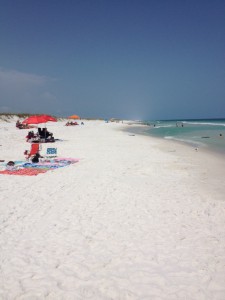
I typically begin my monthly hikes along the Gulf shore to see what is out and about; this month there were humans… and lots of them. This is the time of year that vacationers visit our islands. Traffic is bad, nowhere to park, long lines, etc. But it is part of living on the Gulf coast. We are glad to have visitors to our part of the state. We do ask that each evening they take their chairs, tents, and trash with them. Have fun.
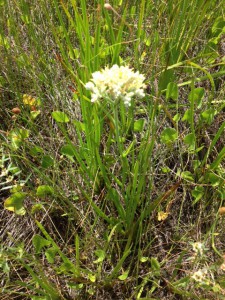
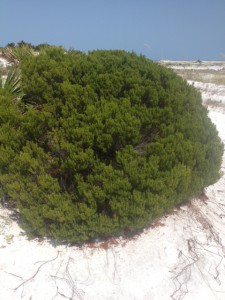
During these hot days of summer this flower was blooming all throughout the freshwater bogs of the secondary dunes. The plant is called REDROOT and it is really pretty. I did not see any insects near it but it was in the warm part of the day that I made my hike this month. The round shaped SEASIDE ROSEMARY is one of my favorite plants on the island. The odor it gives off reminds me of camping out there when I was a kid and of the natural beach in general. I have been told that Native Americans did use it when cooking, but can’t verify that. This is a neat plant either way. I believe there are male and female plants in this species and they have a low tolerance of fire and vehicle traffic.
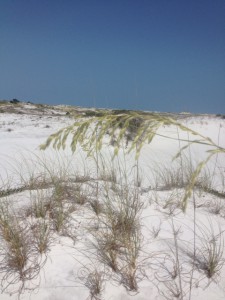
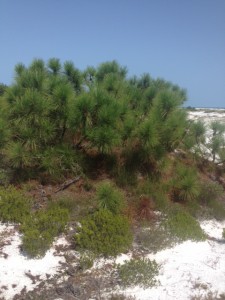
The most famous plant on our barrier islands is the SEA OAT. However most think of them in the primary dune fields only. They actually grow all across the island as long as their seeds fall in a place where the wind is good, usually at the tops of dunes. As many know the roots and rhizomes of this plant are important in stabilizing the dunes, hence the reason why in most states it is illegal to remove any part of the plant. This PINE is the same type found growing 40 feet up in your yard but here on the beach salt spray and wind stunt their growth. Also the moving sand covers much of the trunk, making the tree appear much smaller than it really is. Pines are quite common on the island.
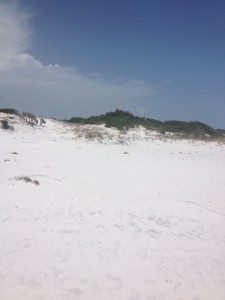
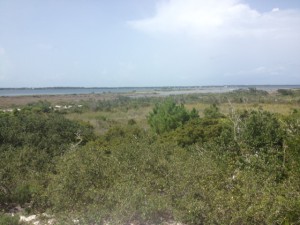
The large trees of the barrier island system are typically found in the TERTIARY DUNE field. Here we see pine, oak, and magnolia all growing forming dunes that can reach 50 feet high in some places. Behind large tertiary dunes are the marshes of BIG SABINE. These marsh systems are some of the most biologically productive systems on the planet. 95% of our commercially valuable seafood species spend most, if not all, of their lives here. We will focus on this ecosystem in another edition of this series Discovering the Panhandle.

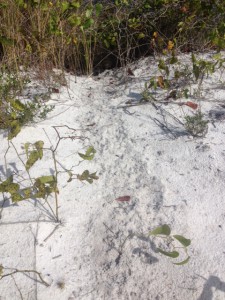
This SWEET BAY is a member of the magnolia family and the small red cones show why. I had not seen the cones until now, so guess they like the heat and rain. WE HAVE SOLVED THE MYSTERY TRACK… knew we would. If you have read the other additions in this series you may recall we have found a track that appeared to be a “slide” coming out of the marsh and into a man-made pond from the old hatchery. Never could determine what was causing this but saw it each month of the year. However this month you could see the individual tracks of a mammal; I am guessing armadillo but could be opossum or raccoon as well. Cool… got that one behind us. On to other discoveries.
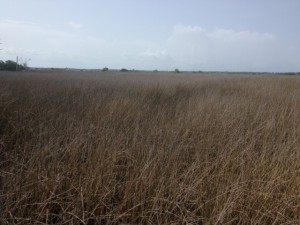
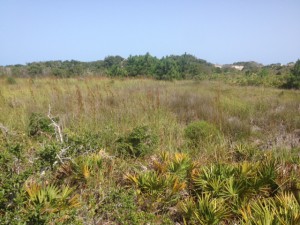
Marshes differ from swamps in that they are predominantly grasses, not trees. Salt marshes, as you would expect, have salt water. Fresh water the opposite… yep. The photo on the left is the salt marsh. The grass species are different and help determine if the water is fresh or brackish. Next year we will do a whole series in this ecosystem – it is pretty cool.
Until next month… enjoy our barrier islands.
 0
0
